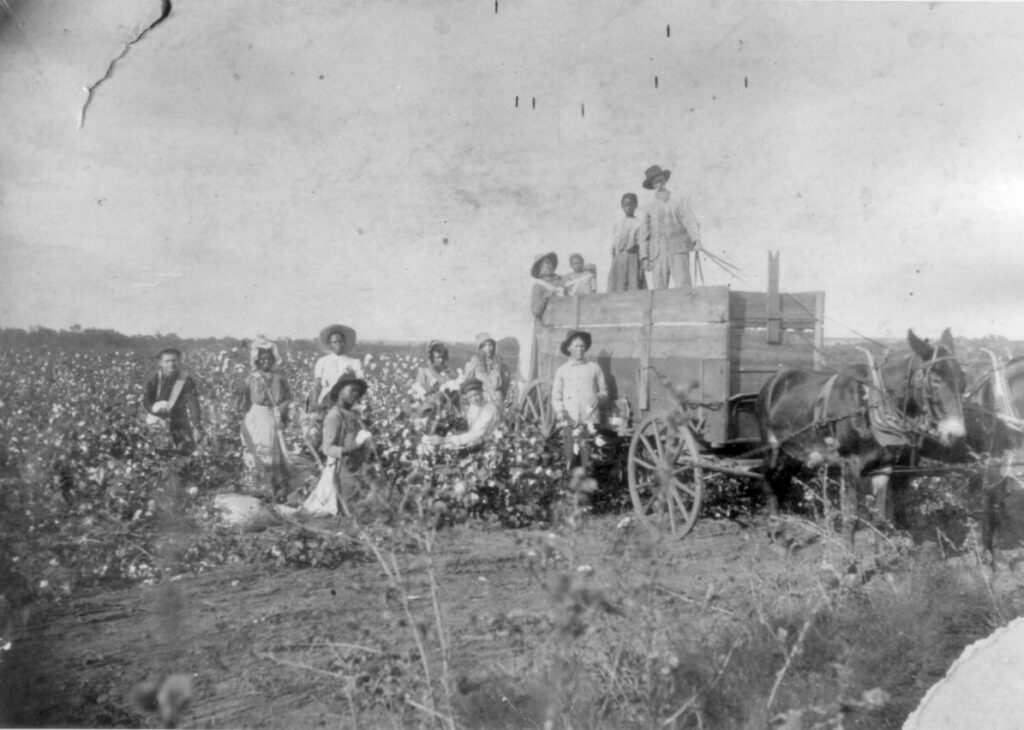By Dr. Curtis Varnell
The cotton row stretched forever. My entire family were employed in picking the white bolls as fast as possible and cramming them into the large canvas sacks they pulled behind their bent bodies. When your livelihood depended on the amount you picked, you had a lot of incentive to get the job done. The going rate in the 1950s was about $2 per hundred pounds and it took a lot of cotton to make a hundred pounds.
Bits and pieces of conversations drifted across the field, drowning out the chirping of the birds or the droning of the dragonflies that constantly inhabited the ends of the row. Sometimes my mother and grandmother would sing, often hymns from church. For a young child, it was a boring, hot, and extremely long day broken up into pieces of time taken for a dipper full of water, a bologna sandwich lunch, or maybe a ride on the sack my mother pulled.
Large crews of people worked the cotton fields; getting the harvest picked, loaded into wagons, and to the cotton gins as rapidly as possible. The crews were made of a diversity of people but with one commonality; poverty and the need to provide for a family.
For years, cotton was the money crop in Arkansas. Much of the economy was determined by the price cotton brought per pound. In the River Valley, prime cotton was grown in the bottoms along the Arkansas, Petit Jean, and Mulberry River. Prime growing property would produce up to two bales of cotton per acre. Upland areas, such as that farmed by my family, would perhaps produce a half-bale per acre during a good year. The labor was intensive with spring plowing and planting followed by weeks of chopping the grass and weeds from around the plants until they became established. Those weeds seemed to grow so much faster than the cotton plants. It was back-breaking work to remove Johnson grass with a hoe. During the ’50s, a man would be rewarded a five-dollar bill for a twelve-hour day of “hoeing.”
My grandfather would plant and establish a crop in early spring and then go to the delta and work in the fields during the summer. A flat-bed truck from the delta farms would pick up workers from the valley, load them on back the truck, and take them east to work on the big plantations during the summer and then bring them home in the fall.
After picking, cotton was taken to a gin where seed was removed and the cotton cleaned and packaged into bales weighing up to five hundred pounds. During the 1800s, steamboats visited Dardanelle, Roseville, Lavaca, and Alma to pick up and deliver the cotton to the Memphis marker. Later, trains took the place of steamboats and delivered cotton to the world market.
In the ’50s, the mechanical cotton picker began to take the place of human labor and fewer and fewer employees were needed. Thousands left the state to find other jobs, leaving a decaying patchwork of towns in the delta and a decreasing population in some of the small towns of the valley.
Farmland devoted to cotton production dropped as the state shifted to other crops. In 1960, cotton took up 33% of the land; in 1980 only 20% of the land was devoted to cotton. Though cotton is not king in Arkansas any longer, it still remains a strong source of income. It was about the only dependable income for my family as I grew up. It was a hard life but, as my mother states, those are the things that shape and make life meaningful.











